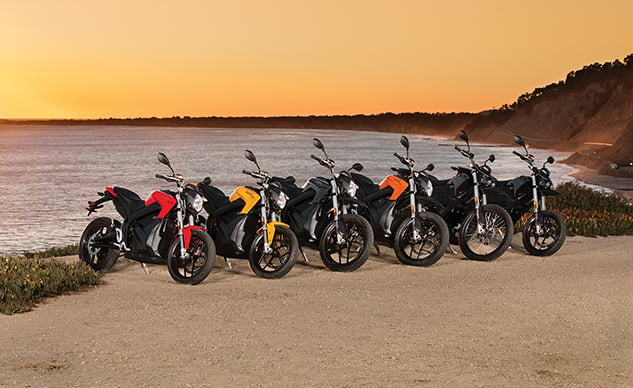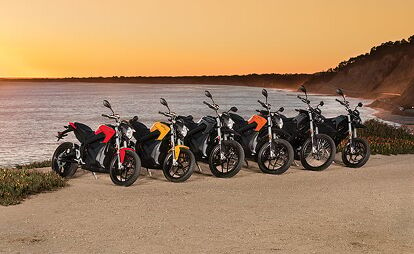2017 Zeros Launched at EICMA

Zero refines its lineup to narrow in on customer needs
Today at EICMA 2016 Zero Motorcycles unveiled its 2017 lineup of electric motorcycles. Although the company didn’t announce any new models, per se, there are some spinoffs of existing models to better suit price points – a request from customers that Zero paid attention to. We’ll cover the model improvements and spinoffs in a moment, but first we’ll start with big news that affects the entire 2017 line.
Zero has long said that its current battery structure will far outlast the life of the bike, but now the company is standing behind its batteries by offering a five-year, unlimited mileage warranty on every 2017 Z-Force power pack.
More good news is that Zero is pairing every bike in its 2017 line with its proprietary, patent-pending interior permanent magnet (IPM) motor, which we tested earlier this year at the racetrack. For those unfamiliar, the IPM motor basically buries the magnets inside the rotor, moving them away from the stator, and thus reducing the amount of heat the magnets are exposed to. The rotor itself also acts as a heatsink, and its shape is slightly wavy instead of being perfectly round, which provides a slight cooling effect. What this means to the rider is the ability to ride harder, longer, and sustain greater top speeds before the motor reaches its thermal limits. And even when those limits are reached, the detrimental effects to the riding experience are much less pronounced than before.
Pair that with the motor controllers on SR and DSR models – whose amperage have now been bumped from 660 amps to 775 amps – and peak torque is rated at 116 lb-ft! Horsepower gets a modest bump from 67 to 70. Zero’s R models already trounced all production sportbikes in the torque department before; now it’s just getting ridiculous. Even if you don’t opt for the R models, the motors for the S, DS, and FX platform all get an amperage upgrade, up to 550 amps from 420, netting the S/DS slight power bumps totalling 60 hp and 81 lb-ft (46 hp and 78 lb-ft for the ZF6.5 models), up from the 54 hp and 68 lb-ft all S/DS models had in 2016. For the FX/FXS platform, torque jumps to 78 lb-ft (from 70) across the board while the ZF6.5 gets 46 hp, up two horses from before. The ZF3.3 stays idle from last year in the horsepower department at 27.
Zero S/DS ZF6.5
Two semi-new models for 2017 are the Zero S and DS ZF6.5. While mostly the same as the other S and DS models, as the name suggests, the ZF6.5 comes equipped with a smaller, 6.5kWh (5.7kWh nominal) battery. Zero’s S/DS platform utilizes a permanent battery comprised of either three or four power packs, depending on the power output the customer desires (a power pack being an individual, modular battery seen on the Zero FX/FXS). The final arrangement of power packs that is then fitted to the S/DS is then colloquially called a “monolith.”
By removing two “bricks” from the monolith, the S or DS ZF6.5 not only sheds about 95 lbs, but it also frees up space for a small, lockable storage compartment where the batteries would have been. Best of all, it also lowers the price to $10,995 compared to $13,995 and $16,690 for the ZF13.0 and ZF13.0 with the optional Power Pack. And that’s before federal and state incentives or rebates. Keen eyes will also note the three brick S and DS models have been dropped from the lineup.
For those who prefer to pay more for range, the Zero S and Zero SR ZF13.0 (11.4kWh nominal, same as last year) models equipped with the optional Power Tank accessory are now rated to exceed 100 miles on the highway and 200 miles in the city. Our experience has shown that real-world riding doesn’t meet these claimed numbers, but the fact remains: Zeros are able to be ridden further and further every year. Despite the ZF13.0 battery pack remaining the same size as last year, Zero says more powerful processors and new engineering innovations in battery architecture simplify cell interconnectivity and are big factors in the improved efficiency.
From an appearance standpoint, a new high-quality paint application process replaces the previous molded-in color body panels. Complementing the painted “tank” area is a new locking, weather-resistant storage compartment, replacing the previous non-lockable zippered pouch compartment.
Zero FX/FXS
Zero’s other platform, the FX/FXS remains relatively unchanged for 2017. Like the S/DS models, the batteries don’t see increased capacity but benefit from the improved processors and internal architecture. However, to help reduce cost both FX models are now available with a permanent integrated battery. This comes as a result of customers telling Zero that they enjoy the FX, but don’t have the need for modular batteries. Pricing is set at $10,495 for the FX/FXS ZF6.5 and $8,495 for the FX/FXS ZF3.3, again not including federal and state incentives and rebates.
In software news, Zero announced an update to its mobile app for 2017 models, allowing updates to the bike’s firmware to be applied directly from the app, thus avoiding a trip to the dealership. And finally, every new Zero sold in the United States will come with a one-year membership to the American Motorcyclist Association and include a year of free roadside assistance.

Troy's been riding motorcycles and writing about them since 2006, getting his start at Rider Magazine. From there, he moved to Sport Rider Magazine before finally landing at Motorcycle.com in 2011. A lifelong gearhead who didn't fully immerse himself in motorcycles until his teenage years, Troy's interests have always been in technology, performance, and going fast. Naturally, racing was the perfect avenue to combine all three. Troy has been racing nearly as long as he's been riding and has competed at the AMA national level. He's also won multiple club races throughout the country, culminating in a Utah Sport Bike Association championship in 2011. He has been invited as a guest instructor for the Yamaha Champions Riding School, and when he's not out riding, he's either wrenching on bikes or watching MotoGP.
More by Troy Siahaan





















































































Comments
Join the conversation
love it!
I've been riding BMW RTs since the 1990s; my latest, a 2007 model, is showing its age. But I only ride it on long road trips 2-3 times a year. It's too much bike for in-town, where an electric would be ideal; but public transit meets my day-to-day needs just fine anyway, aside from the occasional trip where it doesn't. But I need a moto for that occasional local trip that transit doesn't cover, and I also want to be able to take a spirited ride down Skyline to the coast and back without having to worry about range.
So, I'm waiting for an electric moto that can I can take on my favorite local loops - mainly down Skyline, out to the coast, and back to SF - and/or from here to Santa Cruz (better still, Sacramento), on one charge. With built-in wind protection - ideally with an electrically adjustable wind screen (spoiled by my beemer). And full-size touring bags - I use my topcase to hold my full-face helmet and armored jacket when I park, and my backpack when I'm riding, and would like side bags that could hold a weekend's worth of clothes and gear for the occasional getaway. And cruise control would be nice too.
Once someone makes an electric that meets those needs, I'll gladly trade in the beemer, and then rent the latest model for those 2-3 long road trips. I'm hoping it won't be more than another couple years.